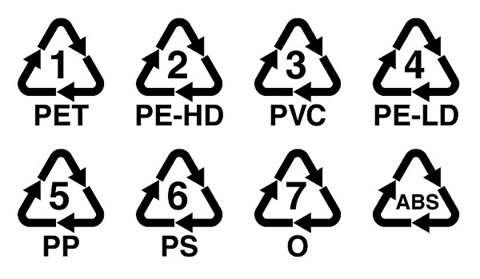Plastic recycling: it's not by numbers

Does it help to know the symbol with the numbers inside?
The short answer: no.
Many people use the triangular symbol with a number inside to identify what can be recycled in the yellow-lid recycling bin. This symbol is NOT a recycling symbol for kerbside recycling. It is a Plastics Identification (PIN) code or number used by manufacturers and plastics recyclers to distinguish the various types of plastic for reprocessing.
What plastics can be recycled in the yellow-lid bin?
Ask yourself these questions:
- Is it a container?
Plastic containers that are rigid or semi-rigid can be recycled.
A helpful hint for deciding if it is semi-rigid is if it generally retains its 3 dimensional shape when crumpled and could hold fluid e.g. biscuit or cake tray.
- Is it made from expanded polystyrene e.g. foam meat or food tray, cup or packaging 'peanuts'?
It must be put in the red-lid waste to landfill bin.
- Is it a plastic lid?
Large lids e.g. ice cream and butter/margarine container lids can be placed in the yellow-lid recycling bin.
Loose small, rigid plastic items e.g. milk and drink bottle lids, bread tags and straws either fall off the conveyor belts at the Material Recovery Facility (MRF) and are treated as waste, or are caught between the paper and cardboard, contaminating that recycling stream. Consequently, loose, small rigid plastic items should be placed in the red-lid waste to landfill bin.
However, they can be recycled if placed inside a milk bottle. When the bottle is full, the lid should be put on and the bottle placed in the recycling bin. Sorters at the MRF will easily be able to identify the milk bottle with lids for recycling with other mixed plastics.
- Is it a soft plastic e.g. plastic bag, film wrap, magazine and newspaper wrap, food packaging?
Soft plastics must be put in the red-lid waste to landfill bin. Some clean, dry, soft plastics can be recycled at some Coles and Woolworths supermarkets.
See recycling bin for more information about what can and cannot go in your recycling bin.
Still not sure how to correctly dispose of an item? Visit the A-Z guide to waste and recycling.
What does this symbol mean?
This symbol is known as the Recycling Mobius and is the universal recycling symbol.
What do the numbers mean?
| Symbol |
Type of plastic |
Common uses |
|
|
Polyethylene Terephthalate
PET
[PET is also referred to as Polyester]
|
- carbonated soft drink, water and juice bottles
- medicine jars
- fibre for clothing and carpet
- strapping and rope
- bags for roasting or boiling food
- some shampoo and mouthwash bottles
|
|
|
High Density Polyethylene
HDPE
|
- milk and cream bottles / containers
- shampoo and conditioner bottles
- cleaning product bottles eg. bleach, detergent
- liners for snack food and cereal boxes
- rigid pipes
- crates, plant pots
- plastic wood, outdoor furniture
- wheelie bins, compost bins, worm farms
|
|
|
Vinyl or Polyvinyl Chloride
V or PVC
|
- clear cordial and juice bottles
- plumbing pipes and fittings
- buttering
- window and door frames
- carpet backing and vinyl floor covering
- credit cards
- synthetic leather products
|
|
|
Low Density Polyethylene
LDPE
|
- squeezable bottles eg. tomato sauce and syrup
- cling film and bubble wrap
- sandwich bags
- shopping bags (re-usable thick bags)
- irrigation pipes
- some bottle tops
|
|
|
Polypropylene
PP
|
- margarine/butter, Ice cream and yoghurt containers
- microwave ware, fridge ware
- most bottle tops
- bags and wrappers e.g. potato chips, biscuits
- hinged lunch boxes
- takeaway containers
- shopping bags (re-usable fabric/woven type)
- prescription bottles
- crates, plant pots
- fabric/carpet fibres
- heavy duty bags/tarpaulins
|
|
|
Polystyrene
PS
And Expanded Polystyrene
Sometimes shown as EPS
|
- yoghurt, margarine, butter containers/tubs
- disposable cutlery and straws
- coat hangers
- seedling trays
- Expanded PS
- packaging foam and 'peanuts'
- meat trays, takeaway cups and shells
|
|
|
Other
All other plastics including acrylic, nylon and bioplastic (PLA - polylactic acid).
|
- some sports drink bottles
- sunglasses
- large water cooler bottles
- CDs
- baby bottles
- medical storage containers
- Polycarbonate (PC)/Perspex
|
What plastics cannot be recycled in the yellow-lid recycling bin?
If the plastic is:
- Expanded polystyrene (a foam plastic labelled PS or EPS) or
- soft plastic (which is essentially two dimensional).
Do not put these items in the yellow-lid recycling bin.
Australasian Recycling Label
You may have noticed a different labelling system on some products. This is the Australasian Recycling Label which is a standardised labelling system for Australia and New Zealand. It aims to provide recycling information to consumers so that they know which parts of their packaging belong in the recycling bin, the rubbish bin, or can be returned to Coles or Woolworths stores at their soft plastic collection bins. For more information visit arl.org.au.
There are three types of recycling information that can appear on a label: